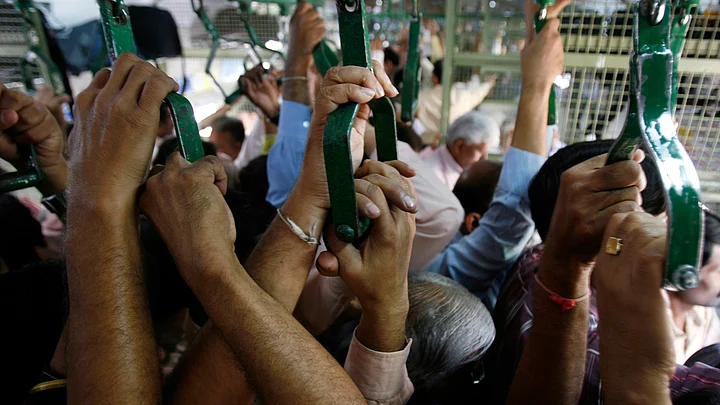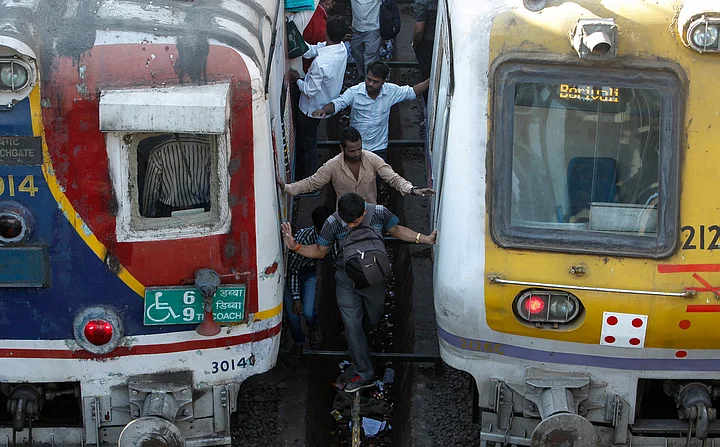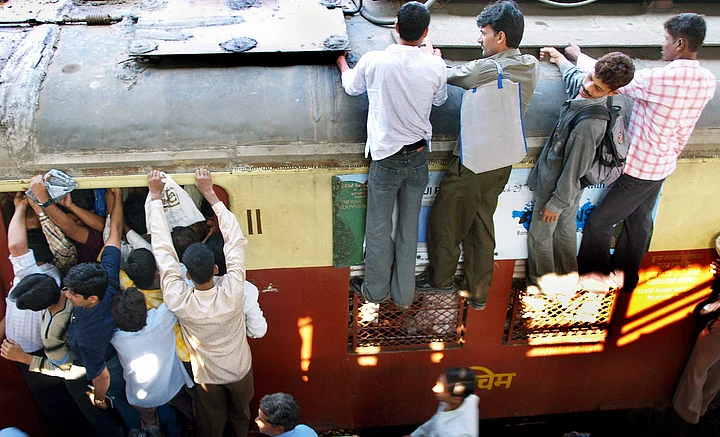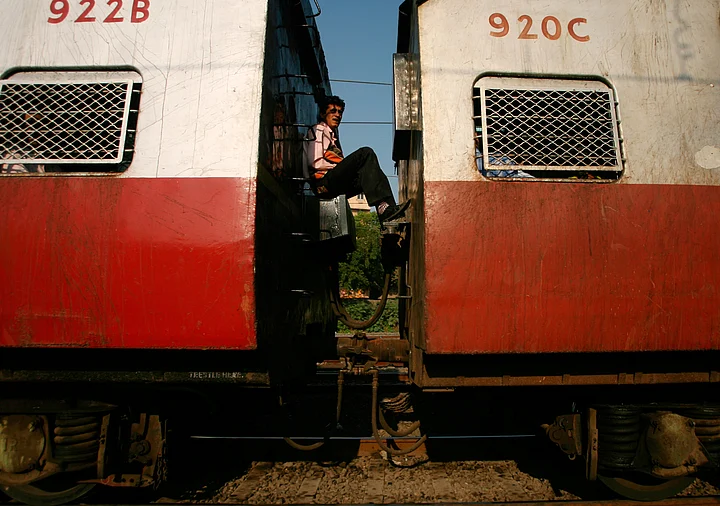Bhavesh Nakate, 22, probably saw his entire life flash in front of his eyes when he realised his grip on the metal pole in the compartment was slipping — his dream to work for a few years and then start his own venture in glitzy Mumbai, Sundays at home meditating, catching cricket matches in this big city of dreams with his brother, and sweet, sweet parents who still haven’t watched the video of their son falling off the train a few seconds later; it has now been nine months.
Just last year, 3,304 were killed on, by or inside a dusty-yellow bullet of clatter going at 110 kilometres per hour, when the schedule permits. Every day, on an average, nine local train commuters don’t go on to reach their destination.
A Term of Its Own
The Mumbai Suburban Railway Network is morbidly called the lifeline of the ever-moving, blurry city of dreams. Now in its 163rd year of service, the network carries a colossal average of 75 lakh passengers a day. But it was neither built nor has expanded its capacity for carrying this load. In fact, engineers found the trend in this network so unique that they gave the locals its very own term: Super-Dense Crush Load.
The iconic compartments of Mumbai locals are designed to carry 1,320 passengers. However, Mumbai being Mumbai, the average number of people on a local train is anywhere between 4,800 and 5,000 people.
It’s basic math: On an average, Mumbai locals run every three minutes. If a peak-hour train is delayed by as little as 10 minutes, more number of passengers fill the narrow platforms until restless commuters form a continuous human chain dangerously near the edge. When the train finally arrives, more than twice as many passengers are itching to secure space for standing or, at least, getting a foot-hold in the train.
What ensues can only be explained as a Darwinian war amongst species, all primal and brutish, elbows and nails. Within minutes, the train leaves the station, almost visibly burdened, with humans everywhere — on the seats, standing inside, hanging outside — and if they’re really desperate or ignorant, on top, ducking under high-voltage overhead cables.
It’s overcrowding like nothing else; well, perhaps just like the city itself. In the last ten years, 25, 722 people have fallen off moving trains, of which 6,989 people died due to losing their grip, falling into the gap while trying to get into a packed compartment, hitting an electric pole outside or doing stunts while hanging off the train.
Don’t Forget to Breathe
Insignificantly tossed into ‘Others’ statistic, deaths due to suffocation, heart attacks and seizures triggered due to a fatal drop of oxygen levels in the body account for five percent of all deaths in local trains.
Sure, it’s a small percentage compared to the 35 percent share of deaths due to falling, but there’s something urgent, and rather preventable, about imagining those 410 people last year who were left gasping for air with no space to even move their hand to loosen their clothing, with no help while ironically being surrounded by thrice as many people.
On 13 September, Arvindasan Krishnan Kutti-Nair, 66 collapsed after having a heart attack in a packed Thane-Vashi train, running late on account of a holiday schedule for Bakrid. He had breathing problems, but no history of heart disease. Around the same time, inside the same train, 40-year-old Anil Gaikwad also collapsed of breathlessness. While Nair was declared dead on arrival at the hospital, luckily all Gaikwad needed was a gust of fresh air.
In 2007, the Railways scrapped its existing BHEL-rakes on account of poor ventilation and switched to Siemens-rakes, which now makes for 60 percent of all trains. In an investigation by Mumbai Mirror this month, 16 of the 18 trains the journalist took through one whole week at different times did not have functional ventilation systems. As of now, only 11 of the 205 running trains have enough fresh air for commuters to make it home unfazed.
Death By Impact
Why shove your way past hundreds of people up and down a long bridge when the opposite platform is right... there? Sixty percent of all local-related deaths were of people who were trespassing – vacuously crossing railway tracks to move from one platform to another, or for no fault of their own, living, playing, washing, bathing, excreting in a dingy slum next to the railway tracks – there’s only so much space in Mumbai for humans and trains.
This problem is a little tricky to solve. For the issues of people crossing railway tracks and being run over, the solution is of changing a mass social behaviour. Sure, the Railways should and must build more bridges over the tracks connecting the platforms, but what about the thousands who don’t use the existing infrastructure in place solely for their safety?
Just Run More Trains
With deaths being constantly reiterated, it is easy to ask frustratedly: Why can’t the Railways just run more trains? After all, more than 50 percent of all deaths in any railway network in the country in the last ten years occurred in Mumbai.
- 01/03Commuters cross railway tracks as trains wait at a suburban station in Mumbai in February 2014. (Photo: Reuters)

- 02/03Indian commuters travel on a overcrowded suburban train by clinging to its top in Bombay in February 2005. (Photo: Reuters)

- 03/03A man travels between two coaches of a suburban train in Mumbai in February 2009. (Photo: Reuters)

Simply put, pumping money into the Mumbai suburban network is not a feasible project for the Railways to undertake; the return on investment is simply too low with passenger fares planned to accommodate the poorest of the poor. Laying down new tracks to run more trains requires land. Not only is it a massive socio-political obstacle, which includes displacement of people and businesses through the agency of the state government, it is also extremely expensive due to the well-known, well-seen scarcity of land in Mumbai.
It is also unyielding for all to ask for a hike in the price for a ticket; if implemented, many would be deprived of public infrastructure crucial to their survival. Besides, to expect the government to increase the fares of this halting, faltering lifeline with millions of its voters on board and elections somehow always being around the corner, is asking for too much, too idealistically.
With an all-resolving solution being decades away from our reach, small but significant efforts made by the Railways can go a long way: having all-weather functional ventilation in all rakes, building more bridges on platforms and fencing around tracks and training personnel for crowd control at stations, including rigorously and honestly penalising those who break the rules by crossing the tracks or by climbing on top of the train.
These solutions will definitely not plug the wound, but to think of even one life saved, one man who makes it home to his family and friends with his dreams intact, is a life well saved. After all, everyone should be able to go about their day without the fear of being violently killed on a train they have no option but to take.



